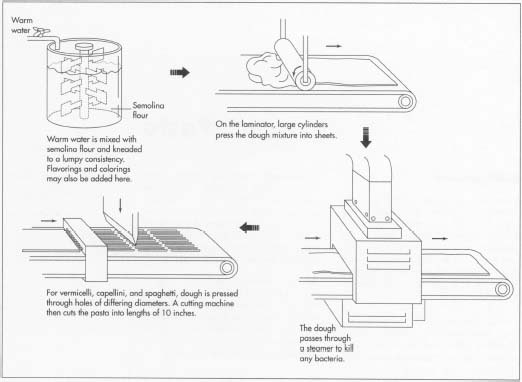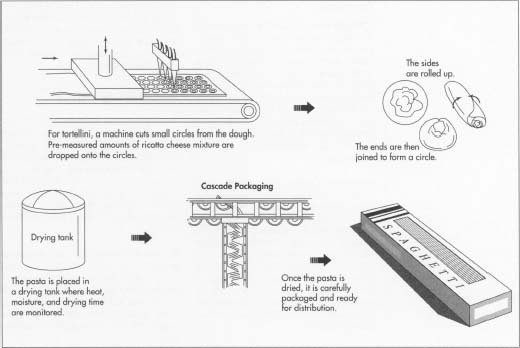Pasta
Background
Pasta is a universally enjoyed food, and almost every country serves a type of noodle. In China, it is mein; Japan, udon; Poland, pierogi; Germany, spaetzle. The popularity of pasta can be attributed to several factors: it is easily manufactured, it takes up little storage space, it is easy to cook, and it is rich in complex carbohydrates.
Ancient Etruscan meals of gruel and porridge were eventually replaced with more appetizing unleavened bread cakes. Food historians believe these cakes may have been the precursor to pasta. Opinions about where the noodle originated vary. The Italian explorer Marco Polo has been commonly credited with bringing the noodle back to Italy from his travels in the Orient during the 1300s. However, some contend that a close examination of Polo's papers reveals that he reported enjoying a certain type of noodle in China, comparing it favorably to the pasta he was accustomed to eating in Italy.
Nevertheless, it is true that Chinese noodles have been around for centuries. The vermicelli-like transparent noodles are made from the paste of germinated mung beans and are usually soaked in water before they are boiled or fried. (Pasta has not always been prepared by boiling. In fact, boiled noodles were once considered a relatively bland meal. Frying or grilling were the preferred preparations.) Koreans claim to have taught the Japanese how to make soba noodles in the 12th century, using Chinese buckwheat grown in the northern regions where rice paddies could not survive.
Early French writers also mention a dish called pastillum, essentially a ravioli-like pouch filled with meat. However, the Italians have staked the claim so vehemently that today we generally think of pasta dishes as Italian in origin. In fact, the word "pasta" comes from the Italian phrase "paste (dough) alimentari (relating to nourishment)."
The first industrial production of pasta occurred in Naples in the early 15th century. The site was chosen for its naturally fluctuating temperatures, sometimes as much as four times a day, which provided the hot and cold temperatures necessary for drying. Mechanical drying was not invented until 1800.
Raw Materials
Pasta is made from a mixture of water and semolina flour. Semolina is a coarse-ground flour from the heart, or endosperm, of durum wheat, an amber-colored high protein hard wheat that is grown specifically for the manufacture of pasta. With a lower starch content and a higher protein content than all-purpose flours, semolina flour is easily digested. Farina, rougher granulations of other high-quality hard wheat, is also used to make some pastas. The semolina and farina flour are enriched with B-vitamins and iron before they are shipped to pasta plants.
Eggs are sometimes added to the mixture for color or richness. Federal guidelines stipulate that egg noodles contain a minimum of 5.5% egg solids. Vegetable juices, such as spinach, beet, tomato, and carrot, can also be added for color and taste. In recent years, the addition of herbs and spices such as garlic, basil, and thyme has become popular.

The Manufacturing
Process
Mixing and kneading
- 1 The semolina is stored in giant silos that can hold up to 150,000 pounds (68,100 kg). Pipes move the flour to a mixing machine equipped with rotating blades. Warm water is also piped into the mixing machine. The mixture is kneaded to a lumpy consistency.
Flavoring and coloring
- 2 Eggs are added to the mixture if the product is an egg noodle. If pasta is to be a flavored variety, vegetable juices are added here. A tomato or beet mixture is added for red pasta, spinach for green pasta, carrots for orange pasta. Herbs and spices can also be folded in for additional flavoring.
Rolling
- 3 The mixture moves to a laminator where it is pressed into sheets by large cylinders. A vacuum mixer-machine further flattens the dough while pressing air bubbles and excess water from the dough to reach the optimum water content of 12%.
Pasteurization
- 4 The roll of dough moves through a steamer, which heats the dough to 220°F (104°C) in order to kill any existing bacteria.
Cutting
-
5 Depending on the type of noodle to be produced, the dough is either
cut or pushed through dies. Ribbon and string-style pasta—such as
fettucine, linguine, spaghetti, and capellini (angel hair)—are
cut by rotating blades. To make tube or shell-shaped pasta such as
rigatoni, ziti, elbow
macaroni, and fusilli, the dough is fed into an extruder which then pushes it through metal dies. The size and shape of the holes in the die determine the type of pasta.

To make vermicelli and capellini, the pasta dough is pushed through holes between 0.8-0.5 mm in diameter. The cutting machine then cuts the pasta into lengths of 10 inches (250 mm) and twists it into curls. Spaghetti ranges from 1.5-2.5 mm in diameter and is left straight.
Tortellini (filled pasta rings) are made on a separate machine. The machine cuts small circles from a roll of dough. A bucket of ricotta cheese mixture drops a pre-measured amount of cheese onto the circle of dough. The dough is then folded over and the two ends are joined to form a circle.
To make ravioli (filled pasta squares), premeasured quantities of cheese filling are dropped by machine at pre-measured intervals on a sheet of pasta. Another sheet of pasta is placed over this sheet as it moves along a conveyer belt. The two layers then pass under a cutting machine that perforates the pasta into pre-measured squares.
Drying
-
6 The pasta is placed in a drying tank in which heat, moisture, and
drying time are strictly regulated. The drying period differs for the
various types of pasta. It can range from three hours for elbow macaroni
and egg noodles to as much as 12 hours for spaghetti. The drying time is
critical because if the pasta is dried too quickly it will break and if
it is dried too slowly, the chance for spoilage increases. The oxygen
level in the tank is also regulated, and lab technicians test frequently
for salmonella and other bacteria.
Careful handling of the pasta during the drying period is also crucial. Spaghetti is the most fragile of the noodles and is therefore hung high above the floor.
Packaging
-
7 Fresh pasta is folded in pre-measured amounts into clear plastic
containers. As the containers move along a conveyer belt, a plastic
sheet covers each container and is sealed with a hot press. At the same
time, a small tube sucks the air of the container and replaces it with a
mixture of carbon dioxide and nitrogen to prolong the product's
shelf-life. Labels listing the type of noodle, nutritional information,
cooking instructions, and expiration date are attached to the top of the
containers.
Dried pasta is loaded, either manually or by machine, into stainless steel buckets (usually of heavy gauge type 304) which move along a conveyer belt to the appropriate packaging station. The pasta is measured by machine into pre-printed boxes, which also list the type of noodle, ingredients, preparation, and expiration date. Again, careful handling is important. For example, because lasagna noodles are particularly fragile, workers place them on metal slides that ease the pasta into boxes. The boxes are then sealed by machine.
Conveying system can be constructed in "S," "C," or "Z" configurations, or as horizontal conveyer belts. These systems move the pasta up and down and across the plant at heights up to 10 feet (3 m). Workers at the floor-level stations monitor the packaging process. The mechanism allows for workers to package the pasta manually if necessary.
Quality Control
The manufacturing of pasta is subject to strict federal regulations for food production. Federal inspectors schedule regular visits to insure that the company is adhering to goverrnment laws. In addition, each company sets its own standards for quality, some of which are set in practice before the pasta reaches the plant. Lab technicians test the semolina flour for color, texture, and purity before it is removed from rail cars. Protein and moisture content are measured and monitored on sophisticated quality control computer software.
In the plant, technicians constantly test the pasta for elasticity, texture, taste, and tolerance to overcooking. Plant workers are required to wear haimets and plastic gloves. Mixing machines are scrupulously cleaned after each batch of pasta passes through them. The drying process is strictly monitored to guard against spoilage.
Homemade Pasta
The popularity of pasta has spread to the home-cooking arena. Pasta-rolling machines and pasta cookbooks are available at house-wares stores and in cooks' catalogs. The recipe for homemade pasta is similar to the industrial process with the exception that eggs are generally used in all home pasta recipes. Sometimes oil is added to the mixture, particularly if a lesser grade of flour is used.
The flour is measured out onto a wooden or marble surface and formed into a mound with a well in the center. Eggs, water, oil and any other desired ingredients are poured into the well and mixed lightly with a fork. Then, beginning from the outside of the mound, the flour is incorporated into the center.
The dough is kneaded for approximately five minutes until a smooth, elastic ball is achieved. Rolling the dough into sheets is done with a long Italian-style rolling pin or with a rolling machine. Most rolling machines have attachments for cutting the dough into various forms of pasta such as spaghetti, fettucine, lasagna, or ravioli. The dough can also be cut by hand using a sharp knife or rolling blade. Specially marked rolling pins that imprint squares on the dough or ravioli trays can be used for making stuffed pasta. Extrusion machines for making tube-style pasta such as rigatoni or fusilli can also be purchased for home use.
The Future
Pasta continues to increase in popularity. The National Pasta Foods Association estimates that the average American will eat more than 29 pounds (13 kg) of pasta each year by the turn of the century. Highly rated for its nutritional value, pasta is an ideal meal for people who are paying more attention to their dietary intake. In addition, people are finding less time to prepare meals, and pasta is easily made.
Pasta manufacturers are responding to this demand by introducing a wide variety of dried and fresh pastas. One recent innovation is no-boil pasta that is partially cooked at the plant, making this already easy-to-prepare food even simpler to bring to the table at mealtime. New lines of fat- and cholesterol-free ravioli are on the market as well as organically-grown pasta products. Two new grains, South American quinoa and Egyptian kamut, are being used to make wheat-free pasta.
Where To Learn More
Books
Bugialli, Guiliano. Bugialli on Pasta. Simon and Schuster, 1988.
Toussaint-Samat, Maguelonne. A History of Food. (Translated from the French by Anthea Bell). Blackwell Publishers, 1992.
Periodicals
Bannon, Lisa. "Italians Do Still Eat Oodles of Noodles, But Trend Is Limp." Wall Street Journal, May 10, 1994, p. Al.
"What Is Pasta?" Borden, Inc., 1994.
"Custom-Manufactured Pasta." Food Engineering, January 1991, p. 71.
Giese, James. "Pasta: New Twists on an Old Product." Food Technology, February 1992, p. 118-26.
McMath, Robert. "Pasta's New World Order." Adweek's Marketing Week, November 25, 1991, p. 26
— Mary F. McNulty